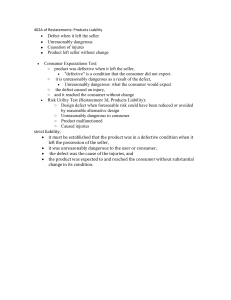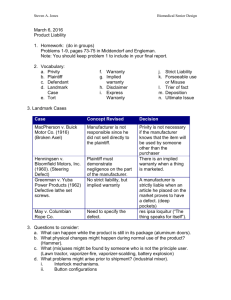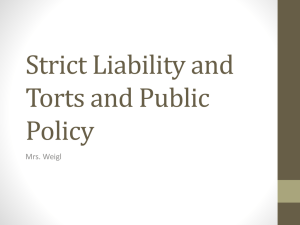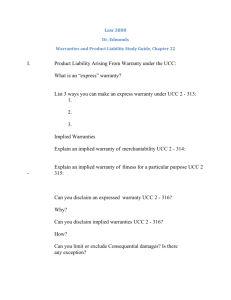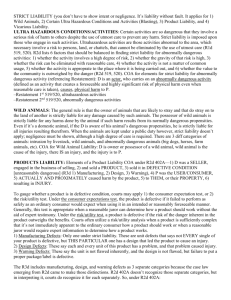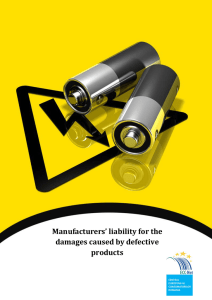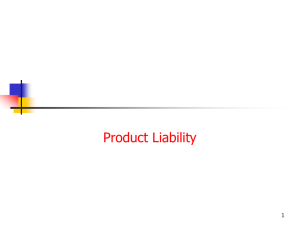Product Liability One
advertisement
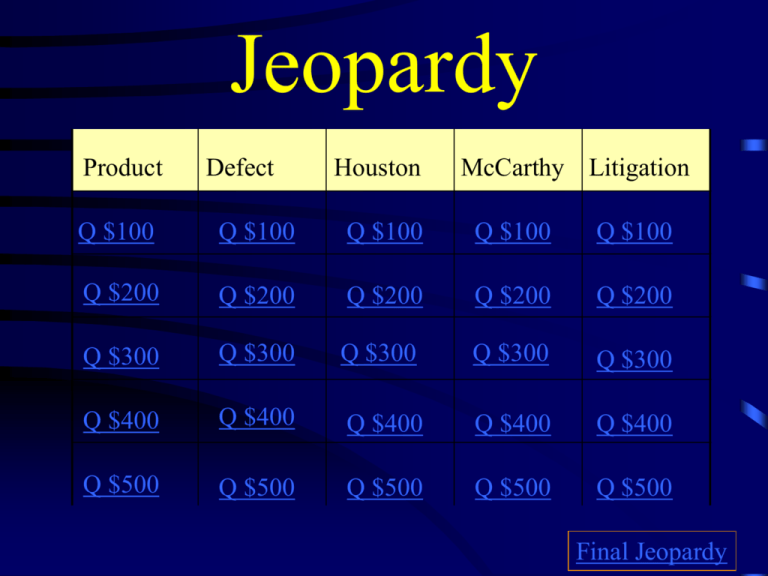
Jeopardy Product Defect Houston McCarthy Litigation Q $100 Q $100 Q $100 Q $100 Q $100 Q $200 Q $200 Q $200 Q $200 Q $200 Q $300 Q $300 Q $300 Q $300 Q $300 Q $400 Q $400 Q $400 Q $400 Q $400 Q $500 Q $500 Q $500 Q $500 Q $500 Final Jeopardy $100 Q: Electricity is a Product … True or False … $100 Answer: Electricity is a Product … True … $200 Q: Hollow-tipped bullets are NOT a “product” because they are too dangerous True or False … $200 Answer False … $300 Q: A “Product” can be the unborn young of animals, as well as growing crops and other identified things attached to realty True or False … $300 Answer True … $400 Q: Money is definitely a “Product” because it is movable at the time of identification to the contract for sale True or False … $400 Answer False … $500 Q: Items such as electricity, real estate, computer software, water, component parts, houses, and pets have been BOTH regarded and disregarded by courts as products for purposes of applying strict liability principles. True or False … $500 Answer True … $100 Q: The Product in Houston was … Electricity, Bullets, Knives, Cottenballs …something else $100 Answer Electricity … $200 Q: Of these 3, which was the dispositive issue: In order to recover for an injury on the theory of strict liability in tort, the plaintiff bears the burden of proving that the defendant: (1) placed in the stream of commerce a product; (2) that such product was in a defective or unreasonably dangerous condition; and (3) that there was a causal connection between such condition and the plaintiff's injuries or damages (1) (2) or (3) $200 Answer (1) Stream of Commerce … $300 Q: The court thought that since the powerline was ten feet higher than required by the National Electrical Safety Code, it met its burden of meeting of complying with applicable codes or ordinances governing the placement of lines. True or False … $300 Answer True … $400 Q: It was held that the parents of the minor child were negligent in letting their child touch the power lines with metal poles. True or False … $400 Answer False … $500 Q: The Houston case might have had a different result of either of these facts were found: 1. The height of the power lines did not meet ordinances and regulations 2. There was evidence that the electricity was delivered into a usable voltage prior to the plaintiff touching the power line. True or False … $500 Answer Perhaps … $100 Q: The hollow-point bullets in McCarthy are NOT a Product because they are too dangerous and should be banned True or False … $100 Answer False … $200 Q: If the hollow-tipped bullets do NOT kill, then they are defective. True or False … $200 Answer False … $300 Q: The court held that it is the job of the legislature to decide if the bullets should even be manufactured. True or False … $300 Answer True … $400 Q: The court discussed product category liability and said that such a concept it would amount to a de facto ban on the product True or False … $400 Answer True … $500 Q: Even though McCarthy lost the case, McCarthy successfully argued that the bullets were defectively designed because they were extra dangerous. True or False … $500 Answer False … $100 Q: A product is in a defective condition unreasonably dangerous to the user when it has a propensity for causing physical harm beyond that which would be contemplated by the ordinary user or consumer who purchases it . . . .” True or False … $100 Answer Yes, that is one definition … $200 Q: Black’s Law Dictionary’s definition of “defective condition” is generally considered as the end-all of how to define “defective condition. True or False … $200 Answer False … $300 Q: The following may all be considered in defining a “defect” 1. Design defect: the existence of a safe alternative design 2. Manufacturing defect: the product deviated from its planned specifications 3. Marketing defect” the product lacked an adequate warning True or False … $300 Answer True … $400 Q: the imposition of strict liability places the burden of the product user’s loss squarely on the manufacturer or seller without the proof of fault, causation, privity, or breach of an express or implied promise. True or False … $400 Answer True … $500 Q: In strict liability actions, the product itself will prove or disprove whether a defect existed in its manufacturing, design, or warning. True or False … $500 Answer True … $100 Q: Almost all state courts have adopted the strict-liability principles cast in Restatement of Tort (Second) § 402A (1965), and many state courts are beginning to recognize the evolution of these principles as set forth in the Restatement of Torts (Third): Products Liability (1997), both of which provide a clear enunciation of strict liability as it applies to defective products True or False … $100 Answer True … $200 Q: Product liability litigation is the resulting dispute between those injured by defective products and ONLY those who sell the product. True or False … $200 Answer False … $300 Q: It is NOT permissible to bring a class action lawsuits alleging that hundreds have been hurt by the same defect in the same product … only an individual person can bring such an action … True or False…. $300 Answer False …. $400 Q: If a federal statute expressly or impliedly preempts a state common law tort action, that action cannot be brought in state court True or False … $400 Answer True … $500 Q: Preemption law is VERY clear, as a result of the United States Supreme Court’s recent decisions interpreting it. See Cipollone v. Liggett Group, Inc., 505 U.S. 504 (1992); Medtronic, Inc. v. Lohr, 518 U.S. 470 (1996). True or False …. $500 Answer False … Final Jeopardy Circumstantial evidence is irrelevant in Product Liability Litigation. Final Jeopardy Answer False …
